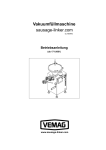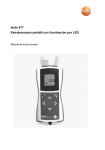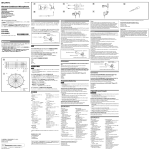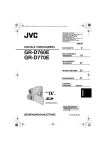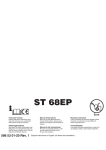Download pdf-download
Transcript
BEDIENUNGSANLEITUNG ERSATZTEILKATALOG OPERATING INSTRUCTIONS SPARE PARTS CATALOGUE 20 10 30 0 ba r 40 KDCNV-200/KDCNV-400 TIPPER TIE technopack GmbH, Otto-Hahn-Str. 5, D-21509 Glinde/Hamburg Tel: (040) 72 77 04-0, Fax: (040) 72 77 04-77, E-Mail: [email protected] 01/02 Doppelclip-Halbautomat KDCNV-200/KDCNV-400 Semi-Automatic-Double-Clipper KDCNV-200/KDCNV-400 Der Vorwärtshub (zur Clipmaschine) sollte bei weicherem Brät ungefähr der Füllgeschwindigkeit der Portion entsprechen. Die Einstellung der Geschwindigkeit erfolgt an dem Drosselrückschlagventil am Darmbremszylinder (Abb. 5c). Die Geschwindigkeit des Rückhubs (zur Füllmaschine) wird am Drosselventil am Schaltkasten (Abb. 5d) reguliert. Um ein Rückziehen des Darms zu verhindern, darf der Rückhub nicht zu schnell erfolgen. Die Füllmaschine wird immer dann gestartet, wenn das Rollenhebelventil (C) (Abb. 6) bei geöffnetem Raffer durchgeschaltet ist, und der Schalter „Automatisch Füllen” in Stellung „EIN” steht. Das Rollenhebelventil löst darüber hinaus die Bewegung der Darmbremse aus. Um den korrekten Zeitpunkt des FüllmaschinenStarts und der Darmbremsbewegung einzustellen, gehen Sie wie folgt vor: 1. Lösen Sie den Sterngriff (A) im Langloch der Schaltkurve (B). 2. Verschieben Sie die Schaltkurve (B) im Langloch in die gewünschte SchaltC stellung. 3. Ziehen Sie den Sterngriff (A) wieder A fest. 5.3 GmbH The forward stroke as well as the return stroke have to be completed before any subsequent machine movements start! 5.2 Einstellen des Schaltpunkts für Füllmaschinenstart und Darmbremsrückhub ® For soft products, the forward stroke (to the clipping unit) should be approximately the same as the stuffing speed. The speed is adjusted via the throttle non-return valve on the casing brake cylinder (fig. 5c). The speed of the return stroke (to the stuffer) is adjusted via the throttle non-return valve on the switch box (fig. 5d). In order to prevent a retraction of the casing, the return stroke must not be too fast. Für den Vorwärts- und den Rückwärtshub gilt: Vor Beginn der nachfolgenden Maschinenbewegungen müssen sie jeweils beendet sein! 5.2 ® Setting the switching point for the stuffer start and the return stroke of the casing brake The stuffing machine is always started when the roller lever valve (C) (fig. 6) was connected with the gatherer opened, and the switch "Automatic Stuffer" is in position "ON". In addition, the roller lever valve actuates the movement of the casing brake. In order to set the correct moment of the stuffer start and the casing brake movement, proceed as follows: 1. Loosen the star knob (A) in the oblong hole of the switching cam (B). 2. Push the switching cam (B) into the B required switch position in the oblong hole. 3. Fasten the star knob (A). Auswählen und 5.3 Selecting and loading the clips The selection of the Abb. 6: Einstellen des Schaltpunkts Fig. 6: Setting the switching point 2 deutsch/englisch 01/02 ® Doppelclip-Halbautomat KDCNV-200/KDCNV-400 Semi-Automatic-Double-Clipper KDCNV-200/KDCNV-400 Einfüllen der Clips ® GmbH correct clips (fig. 8a and 8b ) depends on two factors: Die Auswahl der richtigen Clips (Abb. 8a und 8b) ist von zwei Faktoren abhängig: • The size of the clip must be sufficient to take up the volume of the casing, • Die Größe des Clips muss ausreichen, um das Volumen des Darms aufzunehmen, • • die Härte des Clips muss ausreichen, um dem während der thermischen Behandlung entstehenden Überdruck standzuhalten. the hardness of the clip must be sufficient to withstand the pressure developing during the thermal treatment. Haben Sie den geeigneten Clip ausgewählt, füllen Sie die Clips in die Magazinstangen ein, wie in Abb. 7a und 7b dargestellt. After selecting the correct clip, load the clips into the magazine rods as shown in fig. 7a and 7b. The higher number of a clip type indicates the increased hardness of the clip material (e.g. the clip G201 is harder than the clip G200). a a b Abb. 7b: Einfüllen der Clips Fig. 7b: Loading the clips Abb. 7a: Entfernen des Gewichts Fig. 7a: Removing the weight Die ansteigende Endziffer der Clipreihen drückt die höhere Härte des Materials aus (der Clip G201 ist härter als der Clip G200). G175 G176 G200 G201 5.6 Adjusting the knife The pneumatic knife is started manually with the G225 G228 370 Abb. 8a: Cliptypen für KDCNV-200 Fig. 8a: Clip types for KDCNV-200 390 400 Abb. 8b: Cliptypen für KDCNV-400 Fig. 8b: Clip types for KDCNV-400 releasing lever. Remove the locking pin from the 01/02 deutsch/englisch 3 ® Doppelclip-Halbautomat KDCNV-200/KDCNV-400 Semi-Automatic-Double-Clipper KDCNV-200/KDCNV-400 5.6 Einstellen des Messers Das pneumatische Messer wird manuell über den Auslösehebel gestartet. Sollen die Portionen manuell geschnitten werden, ziehen Sie den Dorn aus der Hebelarretierung (Abb. 13b). Mit dem Handballen kann jetzt das Messer an der gewünschten Stelle nach dem Clippen ausgelöst werden. Soll automatisch im Dauerbetrieb geschnitten werden, muss der Dorn wieder eingesteckt werden (Abb. 13c). ® GmbH releasing lever if the portions shall be cut manually (fig. 13 b). With the palm of your hand the knife can now be actuated after the clipping process. If the portions shall be cut automatically after every portion reinsert the pin (fig. 13c). The knife speed can be lowered pneumatically at the throttle non-return valve for the knife (fig. 13a). Use a screw driver to turn the Die Messergeschwindigkeit screw on the valve kann am Drosselrückclockwise in order to lower schlagventil des Messers the speed. For thin casings (Abb. 13a) pneumatisch gea lower speed may be used. drosselt werden. Dazu dreThe cutting delay can be hen Sie die Schraube im adjusted by means of the Uhrzeigersinn. Bei dünnen throttle non-return valve Abb. 13a: Einstellung von Messerverzögerung Därmen kann mit kleineren (exhaust throttle) in the und Messergeschwindigkeit Geschwindigkeiten gefahsignal line between clipping Fig. 13a: Adjustment of knife delay ren werden. cylinder and PE-converter and knife speed Die Messerverzögerung kann (only on machines with am Drosselrückschlagventil counter). The moment, when the knife cuts, is (Abluftdrossel) in der Signalleitung zwischen Clipzylinder adjusted. If it cuts too early, the casing slips out of the und PE-Wandler eingestellt werden (nur bei Maschinen clip. If it cuts too late, time is lost. mit Zählwerk). Eingestellt wird der Zeitpunkt, wann das Messer schneidet. Schneidet das Messer zu früh, rutscht der Darm aus dem Clip. Schneidet das Messer zu spät, geht Zeit verloren. 5.7 Adjusting the thread dispenser The adjustment of the thread dispenser has to be done in the described order: 5.7 Einstellen des Fadenspenders Abb. 13b: Einstellung: Einzelauslösung des Messers Fig. 13b: Setting: Knife cuts individually 4 Abb. 13c: Einstellung: Dauerschneiden des Messers Fig. 13c: Setting: Knife cuts continuously deutsch/englisch 01/02 ® Doppelclip-Halbautomat KDCNV-200/KDCNV-400 Semi-Automatic-Double-Clipper KDCNV-200/KDCNV-400 Die Einstellung des Fadenspenders erfolgt in der nachfolgend beschriebenen Reihenfolge: 1. Nehmen Sie die Abdeckung (A) des Fadenspenders ab (Abb. 14a). Legen Sie die Garnrolle (Spezialgarn, siehe Anhang I „Technische Daten“) in den Fadenkorb. 2. Ziehen Sie den Faden aus dem Rollenkern, und legen Sie ihn im Fadenspender und durch das Fadenleitblech in die Clipöffnung ein, wie in Abb. 14b dargestellt. 3. Die Fadenlänge wird durch Versetzen des Anschlagbolzens (B) in den vier Bohrungen (Abb. 14b) 1. 2. 3. 4. ® GmbH Remove the cover (A) of the thread dispenser (fig. 14a). Put the thread roll (special thread, see Annex I "Technical data") into the thread holder. Pull the thread out of the roll core, and insert it into the thread dispenser and through the threadguiding plate into the clip opening, as shown in fig. 14b. The length of the thread is determined by plugging the thread bolt (B) into one of the four provided bores (fig. 14b). Fig. 14b shows the adjustment on delivery. Depending on the product to be processed, the B 20 10 30 0 ba r 40 A C D Abb. 14a: Einlegen der Garnrolle Fig. 14a: Inserting the thread roll 4. 5. 5.8 Abb. 14b: Einstellung Fadenspender Fig. 14b: Adjusting the thread dispenser eingestellt. Abb. 14b zeigt die werkseitige Einstellung. Entsprechend des zu fahrenden Produkts muss die Geschwindigkeit des Vor- und Rückhubs des Fadenspenders bestimmt werden. Nehmen Sie diese Einstellung an den Drosselrückschlagventilen am Vorschubzylinder vor (Abb. 14b). Die Geschwindigkeit des Vorhubs wird am oberen Drosselrückschlagventil (C), die des Rückhubs am unteren Drosselrückschlagventil (D) durch Drehen gegen den Uhrzeigersinn erhöht. Schließen Sie die Abdeckung des Fadenspenders, und überprüfen Sie die Einstellung im „Trockendurchlauf”. Einlegen des Schlaufenbandes (manuelle Schlaufe TEBE) 01/02 5. 5.8 speed of the forward and the return stroke of the thread dispenser has to be determined. The adjustment is done via the throttle non-return valves on the feeding cylinder (fig. 14b). The speed of the forward stroke is increased by turning the upper throttle non-return valve (C) counter-clockwise, the speed of the return stroke is increased by turning the lower throttle non-return valve (D) counter-clockwise. Close the cover of the thread dispenser, and check your settings in a "dry run". Inserting the loop tape (manual loop TEBE) Insert the loop tape as described below: deutsch/englisch 5 ® Doppelclip-Halbautomat KDCNV-200/KDCNV-400 Semi-Automatic-Double-Clipper KDCNV-200/KDCNV-400 Legen Sie das Schlaufenband wie folgt ein: 1. Stecken Sie die Schlaufenbandrolle auf die Halterung. Stellen Sie dabei sicher, dass das Schlaufenband vorn abgewickelt wird. Sichern Sie die Rolle mit der Klammer (Abb. 15a). 2. Führen Sie das Bandende, auf dem sich keine Schlaufen befinden, unter dem Auflageblech durch, und fädeln Sie es durch die Halterung am Auflageblech (Abb. 15b). 3. Soll eine Schlaufe in den Clipverschluss eingeclippt werden, ziehen Sie die vordere Schlaufe ab (Abb. 15c), und legen Sie sie über die beiden linken Rafferbleche (Abb. 15d). 6 1. 2. 3. ® GmbH Plug the loop tape roll onto the holder. Make sure, that the loop tape is reeled off on the front side. Fix the roll by means of the clamp (fig. 15a). Lead the end of the tape that does not carry loops underneath the supporting plate, and thread it underneath the holder on the supporting plate (fig. 15b). If a loop is to be clipped into the seal, pull off the first loop (fig. 15c), and apply it above the two left-hand gatherer plates (fig. 15d). Abb. 15a: Einfädeln des Schlaufenbandes Fig. 15a: Threading the loop tape Abb. 15b: Einfädeln des Schlaufenbandes Fig. 15b: Threading the loop tape Abb. 15c: Abziehen der Schlaufe Fig. 15c: Pulling off the loop Abb. 15d: Einlegen der Schlaufe Fig. 15d: Inserting the loop deutsch/englisch 01/02 ® Doppelclip-Halbautomat KDCNV-200/KDCNV-400 Semi-Automatic-Double-Clipper KDCNV-200/KDCNV-400 5.9 1. Einrichten des Schlaufenautomaten mit elektrischem Zähler Schieben Sie eine volle Schlaufenrolle (A) auf die Rollenaufnahme. Achten Sie darauf, dass das Schlaufenband richtig herum abläuft, wie in Abb. 16a, Detail a, gezeigt. Stellen Sie Schalter 3 auf das Symbol für „Haltezylinder“ (ganz links). Der Haltezylinder wird entriegelt. 2. 4 2. Setting up the automatic looper equipped with electrical counter Slide a new loop roll (A) onto the roller support . Take care that the loop tape is reeled off in the correct position as shown in fig. 16a, detail a. Set switch 3 to the symbol for "holding cylinder". The holding cylinder is unlocked. 8 0 1x 1. GmbH 6 2 0 1 2 15 3 14 4 13 5 12 6 11 7 10 9 8 5.9 ® bar 10 1 0 2 A a Stop Start 3 D F b E Abb. 16a: Vorderansicht Fig. 16a: Front view 01/02 deutsch/englisch 7 ® Doppelclip-Halbautomat KDCNV-200/KDCNV-400 Semi-Automatic-Double-Clipper KDCNV-200/KDCNV-400 I K H G 4. Legen Sie das Schlaufenband in der mit Pfeilen gekennzeichneten Reihenfolge ein: Führen Sie das Leerband (ohne Schlaufen) zunächst durch den Haltezylinder (D). Fädeln Sie es dann von unten um das Führungsblech und den Stift (E) und führen Sie es, wie in Abb. 16a gezeigt, zurück über die Umlenkrolle (F) nach oben und durch den Bügel der oberen Umlenkung (Abb. 16b) nach hinten in Richtung Transportrolle (Igel) (G). Das Leerband liegt dabei an der Umlenkung an. Führen Sie das Leerband nun über die Umlenkrolle (H) und um den Igel (G), so dass die Stifte des Igels in die Löcher des Vorlaufbandes greifen (Abb. 16c). a b GmbH G K H Abb. 16c: Draufsicht Fig. 16c: Top view Abb. 16b: Seitenansicht von rechts Fig. 16b: Right side view 3. J ® 3. 4. Insert the loop tape in the order marked by arrows: Insert the empty tape (without loops) through the holding cylinder (D). Thread it first from underneath and then back over the guide plate and under the pin (E). From there, as shown in fig. 16a, guide it backwards and upwards via the deflection roller (F) and through the bracket of the upper deflection (fig. 16b) to the rear towards the taper foot roller (G). The empty tape is aligned closely to the guider. Guide the emtpy tape over the deflection roller (H) and around the taper foot roller (G), so that the spikes of the roller grip into the perforation of the tape (fig. 16c). c d e Abb. 17: Einlegen des Leerbandes Fig. 17: Inserting the empty tape 8 deutsch/englisch 01/02








